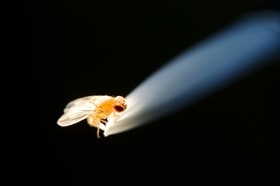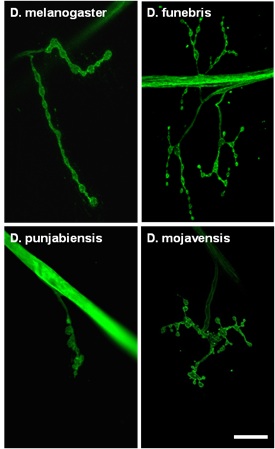Surprising diversity at a synapse hints at complex diversity of neural circuitry
A new study reveals a dazzling degree of biological diversity in an unexpected place — a single neural connection in the body wall of flies.
The finding, reported in this week’s online edition of the Proceedings of the National Academy of Sciences, raises several interesting questions about the importance of structure in the nervous system and the evolution of neural wiring.

A common fruit fly, scientifically known as Drosophila melanogaster, is pictured on the tip of a small brush in a micro-view photograph made in the research lab of genetics professor Barry Ganetzky.
Photo: Jeff Miller
“We know almost nothing about the evolution of the nervous system, although we know it has to happen — behaviors change, complexity changes, there is the addition of new neurons, formation of different synaptic connections,” says geneticist Barry Ganetzky, the Steenbock Professor of Biological Sciences at the University of Wisconsin–Madison.
The result is even more remarkable because he and graduate student Megan Campbell found the surprising diversity in a location very familiar to scientists. Called neuromuscular junction 4 (NMJ4), it’s where a single motor neuron contacts a specific muscle in the fly body wall to drive its activity.
The synapses where neurons connect with their neuronal or muscular targets are morphologically complex, resembling miniature trees decked out with tiny bulbs that are the nerve terminals, called synaptic boutons.
“Synapses are where the important information transfer and integrative functions of the nervous system occur,” Ganetzky explains. “It’s the fundamental place where information processing takes place, and there is an underlying belief that the structure of the synapse is key to understanding its function.”
Each muscle is innervated by a different motor neuron that forms an NMJ with a shape, size, and geometry that is characteristic for that particular NMJ. Fortunately, the consistency of the fly’s anatomy makes it possible to identify the exact same synapse in different individual flies, even across different species. NMJ4 is well studied in the context of synaptic development and function, and Ganetzky himself has used NMJ4 for decades to pinpoint genes with a host of biological roles from movement disorders to neurodegeneration.
The current project began with a simple musing about what really is “normal” for laboratory-bred fruit flies and their wild brethren. Looking at the NMJ4 in the common lab fruit fly, Drosophila melanogaster, Campbell found that the synaptic morphology was consistent between lab-bred and wild flies, and between strains collected in Madison, Wis., and as far away as Zimbabwe. All the flies had similar-looking arbors and boutons.
Encouraged, they decided to branch out. “Drosophila is a very rich genus — thousands of species with different behaviors, different food preferences, different environments, different climates, different sizes — with upward of 50 million years of divergence,” comparable to the evolutionary separation between mice and humans, says Ganetzky.
Despite such differences, he adds, the larval body plan is exactly the same across all known Drosophila species regardless of their size, habitat, or food source. “Cell for cell, the body wall musculature and innervation patterns are identical,” he says.
They began to look at NMJ4 in other Drosophila species, aided by the fly collection of UW–Madison evolutionary biologist Sean B. Carroll. When they focused on their target synapse in 21 different species of Drosophila from around the world, they expected to find some predictable patterns of modest variation.

Each image shows neuromuscular junction 4 (NMJ4), the nerve endings formed by a single motor neuron on the surface of a specific muscle in the larval body wall, in a different species of fly. Surprisingly, NMJ4 in different Drosophila species varies widely in the number and length of synaptic branches, the number of beadlike structures called boutons, and in overall complexity, raising interesting questions about the importance of structure in the nervous system and the evolution of neural wiring.
(Images: Barry Ganetzky and Megan Campbell, University of Wisconsin–Madison)
But after looking at just a few species, Campbell says, a different story emerged: like Drosophila melanogaster, each species had a characteristic NMJ4 appearance, but that appearance varied dramatically among species. In some species, NMJ4 consisted of a few boutons arranged in a simple unbranched pattern; others had many boutons distributed over a number of long branches or numerous boutons packed into dense, tightly clustered arbors.
“The results were absolutely flabbergasting — variation far beyond anything we ever anticipated,” Ganetzky says.
But the surprises didn’t end there.
The striking differences in complexity did not correlate with evolutionary relatedness of the species; in other words, the NMJs of more closely related species did not look any more alike than those of more distantly related flies.
They even found distinct differences between species separated by less than one million years of evolution, species that are otherwise so similar that even fly experts struggle to distinguish them based on appearance. Such rapid evolution is remarkable, the authors say, though its biological significance isn’t yet clear.
What could explain such tremendous variation? One possibility is genetic drift — the random accumulation of genetic changes that alter the appearance of the NMJ but otherwise have no effect on the organism; in essence, any NMJ that gets the job done will suffice. The alternative is that each NMJ is shaped by natural selection because its particular size and structure in some way increases survival or reproductive success for members of that species.
With help from fellow UW–Madison geneticists Bret Payseur and Beth Dumont, they used a quantitative model to analyze the different NMJ morphologies as a function of the evolutionary relationship among 11 species whose evolutionary tree is precisely known from genome sequencing. The results, Ganetzky says, indicate that the variability they observed is unlikely to be random. “What that suggests is that there is some driving force — natural selection — that is shaping the synapse to be a particular way.”
Thinking that neural function would be an obvious target of selection, they measured electrical activity in the circuit. But activity recordings from four species representing the range of morphological complexity revealed the same basic neural workings no matter the synaptic structure.
The researchers say there may be subtle functional differences between the different NMJ structures, undetected by their assay but which could translate to distinct biological differences — for example, learning capacity or response to stressful conditions — that would provide a target for natural selection.
“We believe there’s some reason why the variation matters, but we don’t know yet what that reason is,” Ganetzky says.
Meanwhile Campbell and Ganetzky are now working to understand the underlying genetic and molecular mechanisms as well as the biological significance, if any, of that naturally occurring variation.
“We think we’ve made an important discovery about nature that we think opens up all kinds of new doors. At this point, we’ve raised many, many more questions than we’ve answered… questions about the evolution of nervous systems, evolution of behavior, the relationship between neuronal and synaptic morphology and function,” Ganetzky says. “I hope this captures the interest of scientists in many other fields to apply their own areas of expertise.”
Tags: biosciences, genetics, research




